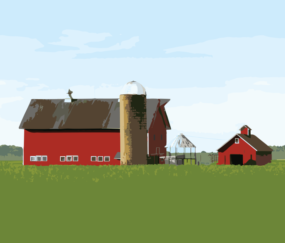The 2019 milk production forecast was reduced by 300 million pounds. At 218.3 billion pounds, 2019 production would be up just 0.3% from 2018.
Cheese and butter price forecasts for 2019 were lowered slightly from last month. The whey price was unchanged but the nonfat dry milk (NDM) price was raised.
Compared to a month ago, the 2019 all-milk price forecast was unchanged at $18.60 per hundredweight (cwt). The projected Class III price was raised a penny to $16.96 per cwt, and the Class IV price was unchanged at $16.30 per cwt.
The 2020 milk production forecast was cut by 400 million pounds to 222.0 billion pounds. If realized, 2020 milk production will rise about 1.7% from 2019.
For 2020, projected prices for cheese, butter and dry whey were all reduced compared to a month ago. As a result, the USDA reduced the 2020 Class III milk price forecast to $17.35 per cwt and the Class IV price to $16.90 per cwt. The 2020 all-milk price is now forecast at $19.25 per cwt.
Beef outlook
Lighter carcass weights are expected to reduce overall beef production in 2020, although output could be up in the first half of the year due to higher-than-expected cattle placements in late 2019.
The 2020 average fed cattle price was projected at $117.50 per cwt, up about 75 cents from the 2019 average of $116.78 per cwt. Highest prices are expected in the first quarter of the year.
The USDA will release its semiannual Cattle report on Jan. 31, providing estimates of heifers held for breeding and an insight into the number of feeder cattle available for placement during 2020.
Lots of crop estimates updated
In addition to the WASDE report, the USDA updated crop production and inventory numbers impacting the cost side of the dairy income ledger. Determining final 2019 corn and soybean production estimates continue to be hampered by weather-related harvest problems.
- Corn: U.S. 2019 corn production was estimated at 13.7 billion bushels, down 5% from 2018. Area harvested for grain was estimated at 81.5 million acres, up less than 1%, while the average yield was estimated at 168 bushels per acre, 8.4 bushels below the 2018 average. Yields were down across most of the Northern Plains and eastern Corn Belt. Record-high yields are estimated in Arizona, Florida, Oregon, Tennessee, Washington and West Virginia.
As of Dec. 1, 2019, corn stored in all positions totaled 11.4 billion bushels, down 5% from a year earlier.
The projected 2019-20 season-average corn price received by producers is $3.85 per bushel, unchanged from last month’s forecast and up 24 cents from the 2018-19 average price.
- Soybeans: Soybean production in 2019 totaled 3.56 billion bushels, down 20% from 2018. Soybean growers harvested 75 million acres, down 14% from 2018, and the average yield was estimated at 47.4 bushels, down 3.2 bushels.
Soybeans stored in all positions on Dec. 1, 2019, totaled 3.25 billion bushels, down 13% from a year earlier.
The U.S. season-average soybean price received by producers for 2019-20 was forecast at $9 per bushel, up 15 cents from the previous month’s forecast. However, the soybean meal price forecast was reduced $5 to $305 per ton.
-
Cottonseed: The 2019 cottonseed harvest was forecast at 6.266 million tons, down about 34,000 tons from last month’s forecast. Despite the downward adjustment, it would still be up about 600,000 tons (11%) from last year.
- Dry hay/forages: Production of all dry hay for 2019 was estimated at 128.9 million tons, up 4% from 2018. Area harvested was estimated at 52.4 million acres, down 1%; the average yield, at 2.46 tons per acre, was up 0.12 ton from 2018.
Production of alfalfa and alfalfa-mixture hay was estimated at 54.9 million tons, up 4% from 2018. Harvested area, at 16.7 million acres, was 1%, and average yield was estimated at 3.28 tons per acre, up 0.11 ton from 2018. Record-high yields were estimated in Idaho and Nevada.
Production of all other hay in 2019 totaled 74 million tons, up 4% from 2018. Harvested area, at 35.7 million acres, was down 2%; average yield was estimated at 2.07 tons per acre, up 0.11 ton from 2018. Record-high yields were estimated in California, Kansas, Maine, Missouri, Montana, Nevada and Utah.
Seventeen states are included in a USDA forage estimation program. Haylage and greenchop production are converted to 13% moisture and combined with dry hay production to derive the total forage production. The total 2019 all haylage and greenchop production for those states was 29 million tons, of which 18.3 million tons were from alfalfa and alfalfa mixtures. The total for all forage production was 83.2 million tons, of which 42.3 million tons were produced from alfalfa and alfalfa mixtures.
Growers seeded 2.47 million acres of alfalfa and alfalfa mixtures during 2019, up 11% from 2018. Wisconsin had a significant increase in alfalfa seedings as a result of winterkill from the previous winter.
-
Corn silage: Corn silage production was estimated at 133 million tons for 2019, up 9% from 2018. Area harvested for silage was up 8% to 6.59 million acres, and the U.S. average yield was estimated at 20.2 tons per acre, up 0.3 ton from 2018.


-
Dave Natzke
- Editor
- Progressive Dairy
- Email Dave Natzke










